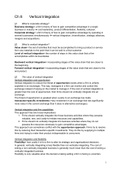Ch 8 Vertical Integration
§1 What is corporate strategy?
Business strategy= a firm’s theory of how to gain competitive advantage in a single
business or industry ➔ cost leadership, product differentiation, flexibility, collusion.
Corporate strategy= a firm’s theory of how to gain competitive advantage by operating in
several businesses simultaneously ➔ vertical integration, diversification, strategic alliances,
mergers and acquisitions.
§2 What is vertical integration?
Value chain= the set of activities that must be accomplished to bring a product or service
from raw materials to the point that it can be sold to a final customer.
Level of vertical integration= the number of steps in this value chain that a firm
accomplishes within its boundaries.
Backward vertical integration= incorporating stages of the value chain that are closer to
the beginning.
Forward vertical integration= incorporating stages of the value chain that are closer to the
end product.
§3 The value of vertical integration
Vertical integration and opportunism
Vertical integration to reduce the threat of opportunism (exists when a firm is unfairly
exploited in an exchange). This way, managers in a firm can monitor and control this
exchange instead of relying on the market to manage it. If the cost of vertical integration is
greater than the cost of opportunism, then firms should not vertically integrate into an
exchange.
The threat of opportunism is greatest when a party to an exchange has made
transaction-specific investments (=any investment in an exchange that has significantly
more value in the current exchange than it does in alternative exchanges).
Vertical integration and firm capabilities
This approach has two broad implications:
1. Firms should vertically integrate into those business activities where they possess
valuable, rare, and costly-to-imitate resources and capabilities.
2. Firms should not vertically integrate into business activities where they do not
possess the resources necessary to gain competitive advantages.
This approach can sometimes conflict with the opportunism approach. Firms try to resolve
this by reducing their transaction-specific investments. They do this by supplying to multiple
firms and trying to make their product indispensable to consumers.
Vertical integration and flexibility
Flexibility= how costly it is for a firm to alter its strategic and organizational decisions.
In general, vertically integrating is less flexible than not vertically integrating. The cost of
exiting a non-vertically integrated business is generally much lower than the cost of exiting a
vertically integrated business.
Flexibility is only valuable when the decision-making setting a firm is facing is uncertain.
1
,A flexibility-based approach to vertical integration suggests that rather than vertically
integrating into a business activity whose value is highly uncertain, firms should not vertically
integrate but should instead form a strategic alliance to manage this exchange.
Opportunism logic suggests starting with a search for transaction-specific investments.
Capabilities logic suggests starting with a search for valuable, rare, and costly-to-imitate
resources and capabilities.
Flexibility logic suggests starting by looking for sources of uncertainty in an exchange.
§4 Vertical integration and sustained competitive advantage
Of course, for vertical integration to be a source of sustained competitive advantage, not
only must it be valuable, it must also be rare and costly to imitate, and a firm must be
organized to implement it correctly.
The rarity of vertical integration
● Rare transaction-specific investment ➔ a firm may have developed a new
technology or a new approach to doing business that requires its business partners
to make substantial transaction-specific investments.
● Rare capabilities ➔ if a firm can conclude that it has unusual skills and those
capabilities are valuable and rare.
● Rare uncertainty ➔ a firm may be able to gain an advantage from vertically
integrating when it resolves some uncertainty it faces sooner than its competition.
Whenever a firm is among the first in its industry to conclude that the level of specific
investment required to manage an economic exchange is no longer high, or that a particular
exchange is no longer rare or costly to imitate, or that the level of uncertainty about the value
of an exchange has increased, it may be among the first in its industry to vertically
dis-integrate this exchange ➔ (temporary) competitive advantage.
The imitability of vertical integration
● Direct duplication of vertical integration ➔ to the extent that these resources and
capabilities are path dependent, socially complex, or causally ambiguous, they may
be immune from direct duplication ➔ sustained competitive advantage.
● Substitutes for vertical integration ➔ strategic alliances
§5 Organizing to implement vertical integration
Organizational structure
A functional or U-form structure is used to implement a vertical integration strategy.
The CEO has the responsibility of strategy formulation and strategy implementation. The
CEO’s job is to help resolve conflicts in ways that facilitate the implementation of the firm’s
strategy.
Management controls
● Budgeting process ➔the use of budgets can lead functional managers to
overemphasize short-term behavior that is easy to measure and underemphasize
longer-term behavior that is more difficult to measure.
● Management committee oversight process
2
, ○ Executive committee ➔ CEO and two or three key functional senior
managers that reviews the performance of the firm on a short-term basis,
weekly meetings.
○ Operations committee ➔ CEO and each of the heads of the functional areas
included in the firm that tracks firm performance over longer time intervals
and monitor longer-term strategic investments and activities, monthly
meetings.
Compensation policies
● Opportunism
○ firm-specific investments= investments made by employees that have more
value in a particular firm than in alternative firms.
○ Task of compensation policy is to create incentives for employees whose
firm-specific investments could create great value to actually make those
investments.
○ Example: salary, cash bonuses for individual performance, stock grants for
individual performance.
● Capabilities ➔ focus on firm-specific investments made by groups of employees
○ Compensation policy should do the same as with opportunism while also
recognizing that these investments will often be collective in nature.
○ Example: cash bonuses for corporate or group performance, stock grants for
corporate or group performance.
● Flexibility
○ Compensation that has fixed and known downside risks and significant
upside potential would encourage employees to choose and implement
flexible vertical integration strategies.
○ Example: stock options for individual, corporate, or group performance.
3
, Ch 9 Corporate diversification
§1 What is corporate diversification?
A firm implements a corporate diversification strategy when it operates in multiple
industries or markets simultaneously. When a firm operates in multiple industries
simultaneously, it is said to be implementing a product diversification strategy. When a
firm operates in multiple geographic markets simultaneously, it is said to be implementing a
geographic market diversification strategy. When a firm implements both types of
diversification simultaneously, it is said to be implementing a product-market
diversification strategy.
Types of corporate diversification
● Limited corporate diversification
○ Single-business firms (>95% of revenues in one business)
○ Dominant-business firms (70-95% of revenues in one business)
● Related corporate diversification
○ Related-constrained diversified firms (<70% of revenues in one business, all
businesses in the portfolio share the same economies of scope)
○ Related-linked diversified firms (<70% of revenues in one business,
businesses in the portfolio share different economies of scope)
● Unrelated corporate diversification
○ Unrelated diversified corporation (<70% of revenues in one business, no or
very limited economies of scope realized across the portfolio of businesses)
An economy of scope exists when the value created by several businesses operated
together is greater than the value of these businesses operated separately.
§2 The value of corporate diversification
Corporate diversification is valuable if there is some valuable economy of scope among the
multiple businesses in which a firm is operating and it must be less costly for managers in a
firm to realize these economies of scope than for outside equity holders on their own
What are valuable economies of scope?
1. Shared activities
Many shared activities can have the effect of reducing a diversified firm’s costs. This is
especially the case if these shared activities are subject to economies of scale.
Shared activities can also increase revenues
● Shared product development and sales activities may enable the offer of a bundled
set, which could be of more value to the customer
● Exploiting the strong positive reputations of some of a firm’s businesses in other of its
businesses
Limitations of activity sharing
● Substantial organizational issues
● Limit the ability of a business to meet its specific customers’ needs
● Bad reputation from one business can spread to others
4







